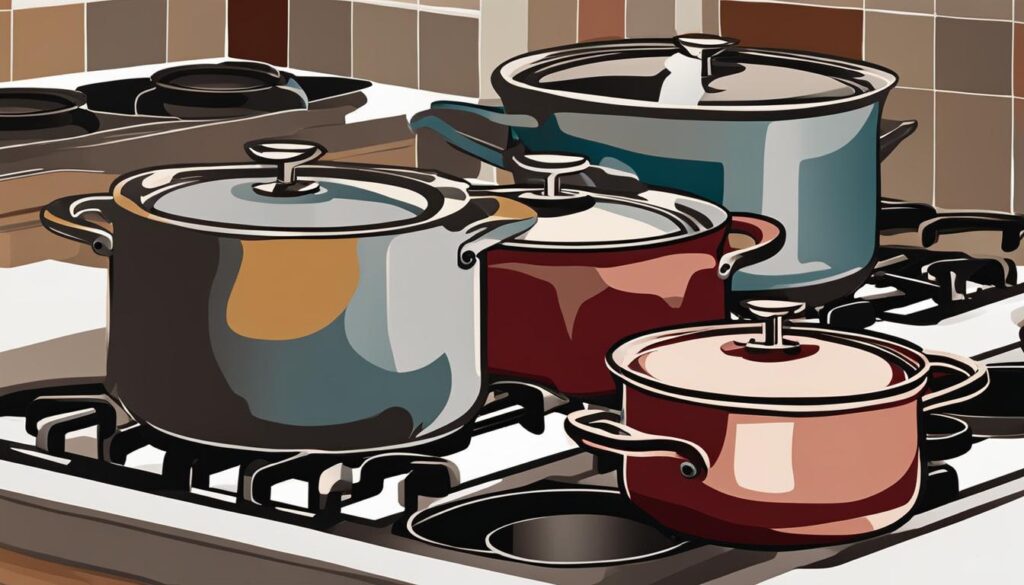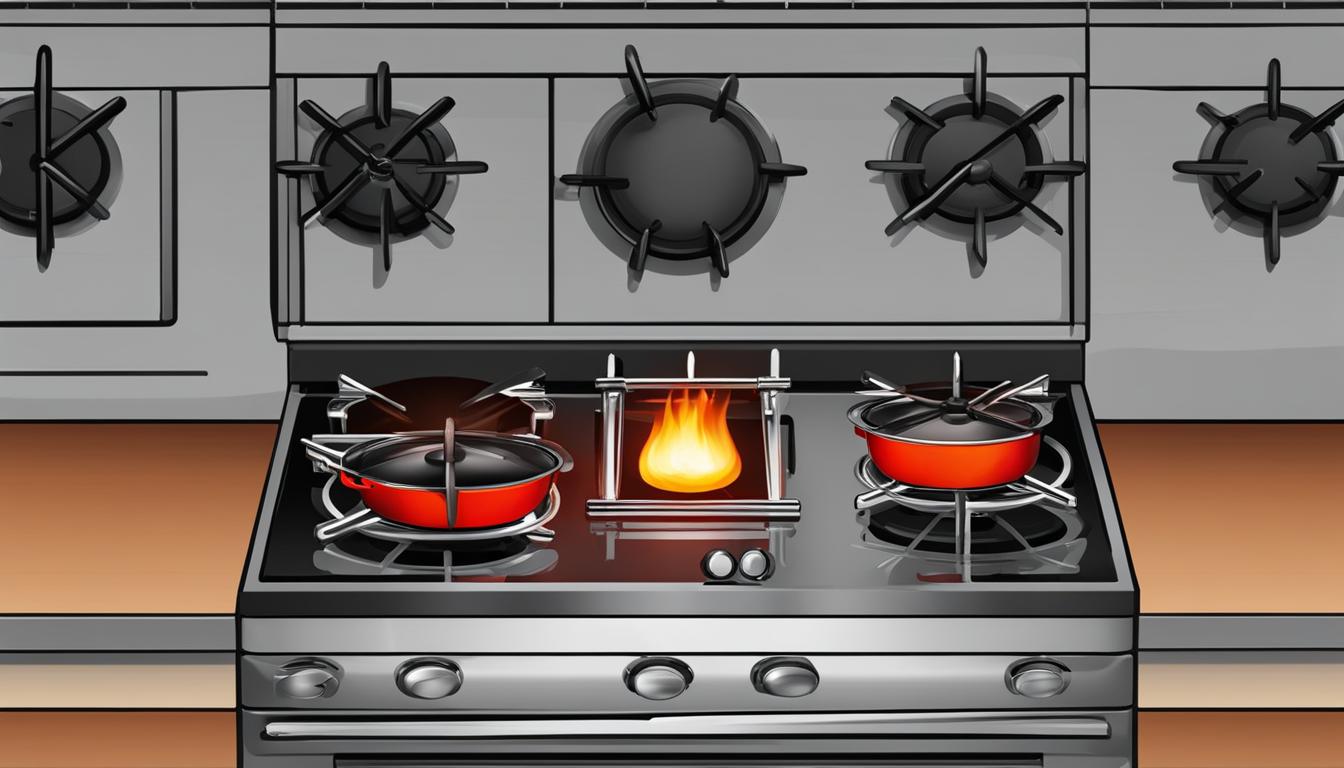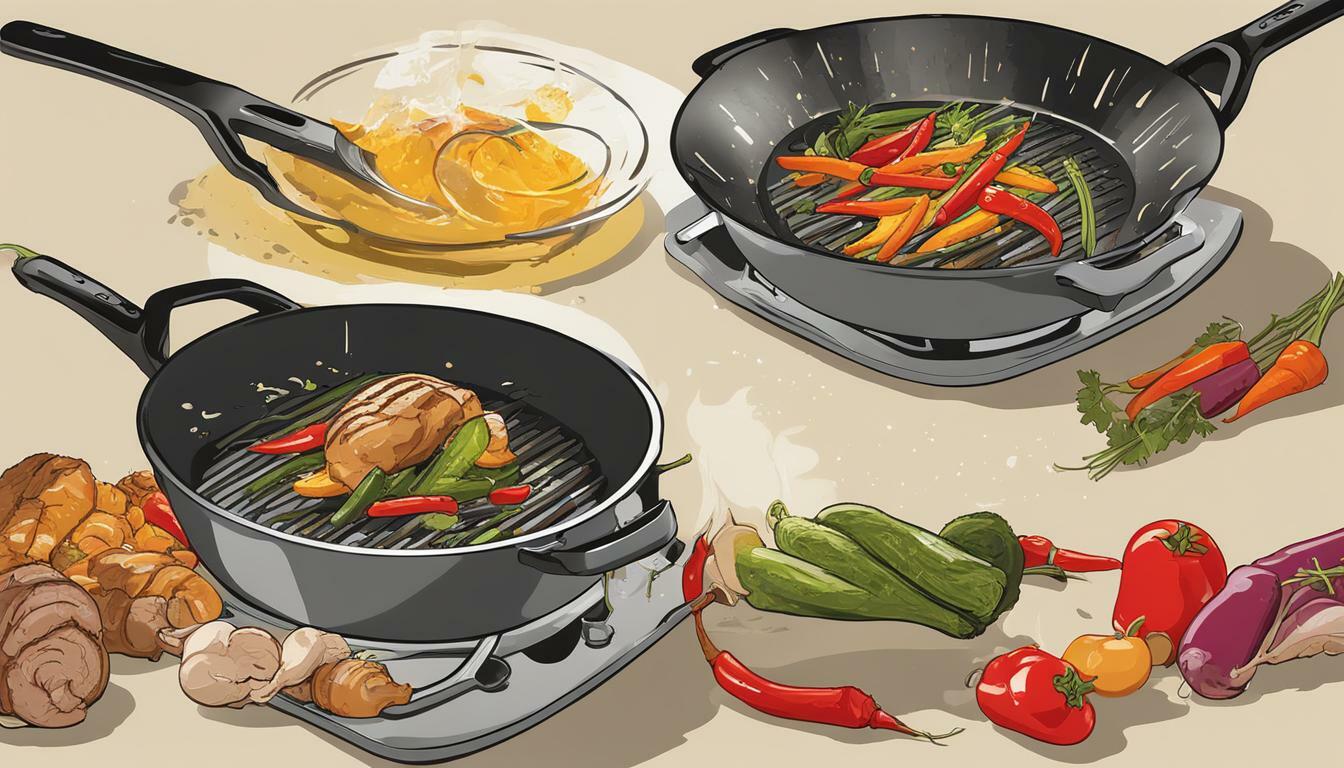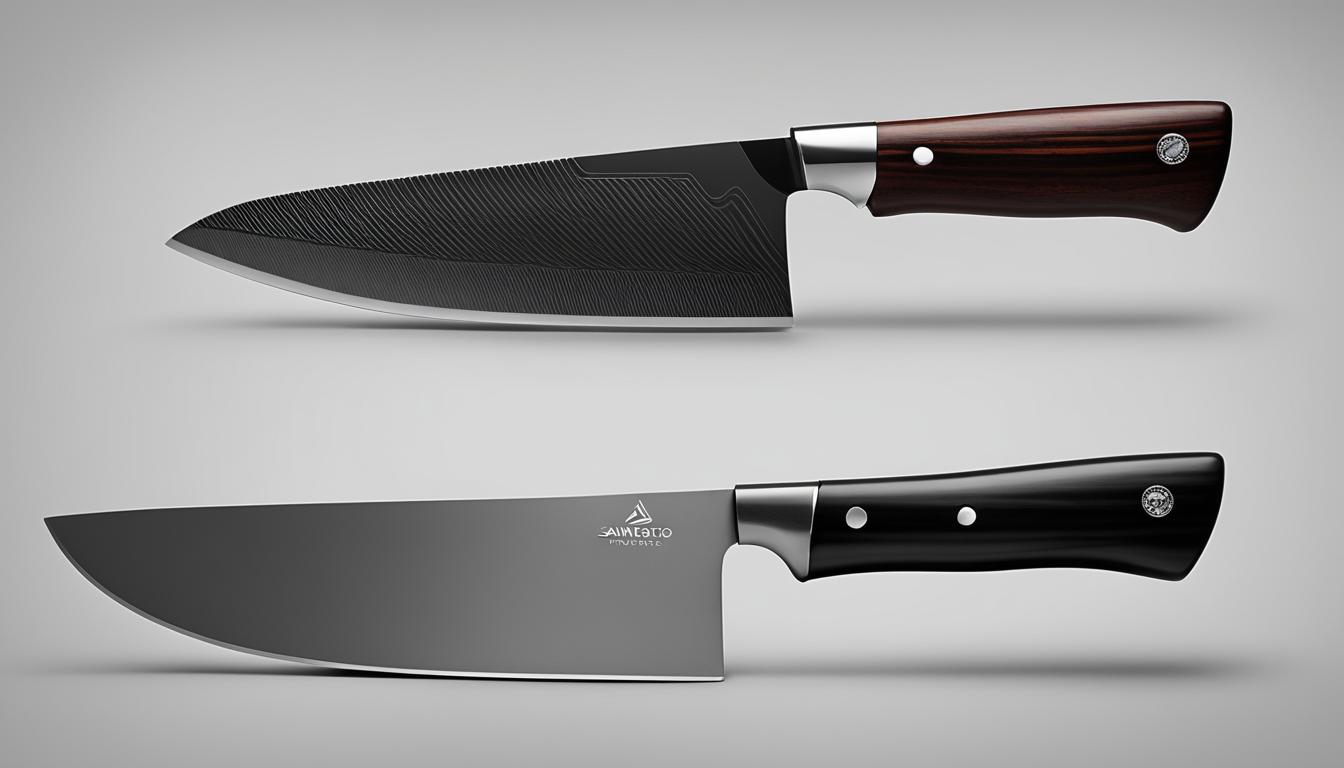Dutch ovens and stock pots are both essential tools in the kitchen, but they have distinct characteristics that set them apart. Understanding the differences between a Dutch oven and a stockpot can help you choose the right tool for your cooking needs.
Dutch ovens are typically made with cast iron and feature an enamel coating. They are shorter and squatter in shape compared to stock pots. Dutch ovens excel at cooking dishes low and slow, making them perfect for braises and one-pot bean dishes. With their tight-fitting lids, Dutch ovens help lock in heat and moisture, resulting in tender and flavorful dishes.
On the other hand, stock pots are usually made of stainless steel and have a taller and more cylindrical shape with straight sides. They are designed for making stocks, broths, soups, and large quantities of liquid-based dishes. Stock pots provide ample space for cooking large volumes of liquid without the risk of spills.
Now let’s dive deeper into the specifics of Dutch ovens and stock pots to understand their uses, features, and differences.
Key Takeaways:
- Dutch ovens are made with cast iron and have an enamel coating, while stock pots are typically made of stainless steel.
- Dutch ovens are shorter and squatter, ideal for braises and one-pot dishes, while stock pots are taller with straight sides, perfect for making stocks and soups.
- Dutch ovens excel at cooking low and slow, while stock pots are designed for large quantities of liquid-based dishes.
- Both Dutch ovens and stock pots are versatile tools, but Dutch ovens offer greater cooking versatility.
- The storage and price of Dutch ovens and stock pots can vary due to their different materials and construction.
What Is a Dutch Oven?
A Dutch oven is a versatile and heavy cooking tool that is commonly used for braising and slow cooking. It is typically made with cast iron and features an enamel coating for easy cleaning. Dutch ovens are known for their excellent heat retention and distribution, making them ideal for cooking dishes low and slow. They are designed to be used on both stovetops and in ovens, allowing for a wide range of cooking methods.
The tight-fitting lid of a Dutch oven helps to lock in heat and moisture, resulting in tender and flavorful dishes. This makes it a great tool for tenderizing tough cuts of meat and creating delicious stews and soups. Dutch ovens are also versatile enough to be used for other dishes such as one-pot bean dishes and bread baking. Additionally, their enamel exterior makes them suitable for serving dishes and adds a touch of elegance to the table.
Overall, Dutch ovens are highly regarded in the culinary world for their durability, versatility, and ability to create delicious and comforting meals. Whether you’re braising a pot roast, simmering a hearty stew, or baking a crusty loaf of bread, a Dutch oven is a must-have tool in any kitchen.
The Benefits of Using a Dutch Oven
- Excellent heat retention and distribution
- Perfect for braising and slow cooking
- Tight-fitting lid locks in heat and moisture
- Versatile for a wide range of cooking methods
- Enamel exterior adds elegance and is suitable for serving
- Durable and long-lasting
What Is a Stock Pot?
A stock pot is a classic kitchen tool that is essential for making stocks, broths, soups, and other liquid-based dishes. It is a tall and cylindrical pot, typically made of stainless steel. The design of a stock pot features straight sides and a wide diameter, providing ample space for cooking large volumes of liquid without the risk of spills. Stock pots are lightweight compared to Dutch ovens and usually come with small handles on the side for easy maneuvering.
Due to their shape and size, stock pots are perfect for simmering ingredients over long periods, allowing flavors to meld and develop. The ability to accommodate large quantities of liquid makes them ideal for cooking stocks from scratch or preparing batch quantities of soups, stews, chilis, or pasta. With their generous capacity, stock pots are also commonly used in professional kitchen settings and for catering purposes.
To summarize, a stock pot is a tall, cylindrical pot specifically designed for cooking liquid-based dishes in large volumes. Its straight sides and wide diameter ensure efficient heat distribution and prevent spills. Stock pots are lightweight and have small handles for easy handling. They are an essential tool in any kitchen, particularly for making stocks, soups, and stews.
Table: Differences between Dutch Oven and Stock Pot
| Feature | Dutch Oven | Stock Pot |
|---|---|---|
| Material | Cast iron with enamel coating | Stainless steel |
| Shape | Shorter and squatter | Tall and cylindrical |
| Use | Braising, one-pot bean dishes, bread baking | Making stocks, soups, stews, chilis |
| Heat Retention | Excellent | Faster heat-up |
| Storage | Bulky, not stackable | Lightweight, stackable |
Similarities Between Dutch Ovens and Stock Pots
Although Dutch ovens and stock pots have their unique characteristics, there are also several similarities between the two types of cookware.
Similar Construction Materials
Both Dutch ovens and stock pots are typically made of metal, although different types of metal are used. Dutch ovens are commonly constructed with cast iron, known for its excellent heat retention and even heat distribution. Stock pots, on the other hand, are often made with stainless steel, which offers durability and resistance to corrosion.
Versatility in Cooking
Both Dutch ovens and stock pots are versatile in the kitchen, allowing for a wide range of cooking techniques and recipes. Dutch ovens can be used for slow cooking, such as braising meats, simmering stews, or baking bread. Similarly, stock pots are ideal for making stocks, broths, soups, and boiling pasta. Both cookware options can handle large volumes of food, making them suitable for feeding a crowd or preparing batch meals.
Even Heat Distribution
One common feature of Dutch ovens and stock pots is their ability to distribute heat evenly during cooking. This ensures that food cooks uniformly and prevents hot spots that could lead to uneven cooking. Whether you’re searing meat in a Dutch oven or boiling pasta in a stock pot, you can rely on consistent heat distribution for desirable results.
| Dutch Oven | Stock Pot |
|---|---|
| Versatile for slow cooking | Ideal for making stocks and soups |
| Made with cast iron | Constructed with stainless steel |
| Excellent heat retention | Good heat conductivity |
| Tight-fitting lid for moisture retention | Loose-fitting lid for easy stirring |
In summary, Dutch ovens and stock pots share similarities in construction materials, versatility in cooking, and even heat distribution. While Dutch ovens are often associated with slow cooking and baking, stock pots excel in preparing stocks and soups. Both cookware options offer reliable performance and are essential additions to any kitchen.

What Makes Them Different?
Dutch ovens and stock pots may appear similar at first glance, but their differences lie in their design, features, and intended uses. Understanding these distinctions will help you choose the right cookware for your cooking style and preferences.
Dutch Oven Features
Dutch ovens are known for their sturdy construction and versatility. They are typically shorter and squatter in shape, with a cast iron core and an enamel finish. The cast iron core provides excellent heat retention and distribution, while the enamel finish offers easy cleaning and prevents rusting. The tight-fitting lid helps lock in heat and moisture, making it ideal for slow-cooked dishes, braises, one-pot bean dishes, bread baking, and even serving dishes. Dutch ovens come in various sizes and shapes, allowing you to choose the one that best suits your needs.
Stock Pot Features
Stock pots, on the other hand, are designed specifically for cooking liquid-based recipes. They are typically taller and more cylindrical in shape, with straight sides and a loose-fitting lid. Stock pots are made of stainless steel, which makes them lightweight and easy to handle. The wide diameter and generous capacity of stock pots make them perfect for making stocks, soups, stews, chilis, and pasta dishes. They are less heavy compared to Dutch ovens, making them easier to maneuver in the kitchen.
| Dutch Oven | Stock Pot | |
|---|---|---|
| Material | Cast iron with enamel coating | Stainless steel |
| Shape | Shorter and squatter | Taller and more cylindrical |
| Uses | Braising, slow cooking, bread baking, serving dishes | Making stocks, soups, stews, chilis, pasta dishes |
| Heat Retention | Excellent | Good |
| Weight | Heavy | Lighter |
While both Dutch ovens and stock pots have their unique features and uses, having both in your kitchen can provide you with more cooking versatility. Dutch ovens are perfect for slow-cooked dishes and versatile enough to be used for various recipes. Stock pots, on the other hand, excel at cooking liquid-based dishes in large quantities. Consider your cooking needs and preferences to determine which cookware will be the most valuable addition to your kitchen.
Storage and Price
When it comes to storage, Dutch ovens and stock pots have some notable differences. Dutch ovens, with their bulkiness and weight, can be more challenging to store compared to stock pots. Their cast iron construction and enamel coating require careful handling to prevent scratching or chipping. It is not recommended to stack Dutch ovens with other pots to avoid damage. On the other hand, stock pots, being lighter and thinner, are easier to store and can be stacked with other cookware, saving precious cabinet space.
As for price, Dutch ovens generally tend to be more expensive than stock pots. This is especially true for premium brands that offer high-quality enamel-coated cast iron Dutch ovens. However, the price can vary depending on the brand, size, and materials used. Stock pots, being made of stainless steel, are generally more budget-friendly options. They come in a range of prices, depending on the brand and size, making them a more affordable choice for home cooks.
| Dutch Oven | Stock Pot | |
|---|---|---|
| Storage | Challenging due to bulkiness and weight | Easier to store and can be stacked with other cookware |
| Price Range | Generally more expensive, especially for premium brands | More budget-friendly options |
Ultimately, the storage considerations and price range of Dutch ovens and stock pots should be taken into account when making a decision. If space is a concern and budget is limited, a stock pot may be the more practical choice. However, if you value the versatility and durability of a Dutch oven and are willing to invest in a higher-quality cookware piece, it can be a worthwhile addition to your kitchen.
Key Points:
- Dutch ovens can be more challenging to store due to their bulkiness and weight.
- The enamel coating of Dutch ovens requires careful handling to prevent scratching or chipping.
- Stock pots, being lighter and thinner, are easier to store and can be stacked with other cookware.
- Dutch ovens are generally more expensive than stock pots, especially premium brands.
- Stock pots offer a more budget-friendly option for home cooks.
Versatility and Uses
When it comes to versatility, Dutch ovens offer a wide range of cooking options compared to stock pots. Their ability to be used on both stovetops and in ovens makes them perfect for various cooking methods. Dutch ovens are commonly used for stewing, braising, boiling, frying, roasting, and even baking. Their heavy construction and tight-fitting lids provide excellent heat retention, making them ideal for slow-cooking dishes and tenderizing tough cuts of meat.
On the other hand, stock pots are primarily used on stovetops for recipes that require a large volume of liquids, such as stocks, broths, soups, and pasta. They heat up faster than Dutch ovens due to their thinner construction, making them more efficient for quickly boiling water or simmering soups. However, their tall and cylindrical shape limits their use to liquid-based dishes.
In summary, Dutch ovens offer greater versatility in terms of cooking methods and the variety of dishes that can be prepared in them. From hearty stews to crusty homemade bread, Dutch ovens are the go-to tool for many home cooks. Stock pots, on the other hand, excel in recipes that require a large volume of liquids and are perfect for making stocks and soups in large batches. Both Dutch ovens and stock pots have their unique uses and are essential additions to any well-equipped kitchen.
The Versatility of Dutch Ovens:
- Braising
- Stewing
- Boiling
- Frying
- Roasting
- Baking
The Uses of Stock Pots:
- Making stocks
- Preparing broths
- Cooking soups
- Simmering pasta
Conclusion
In conclusion, both Dutch ovens and stock pots offer unique benefits in the kitchen. Dutch ovens are known for their versatility and ability to cook low and slow, making them perfect for braises, one-pot dishes, and even bread baking. Their cast iron construction and enamel coating provide excellent heat retention and make them suitable for serving dishes as well.
On the other hand, stock pots are specifically designed for liquid-based recipes such as stocks, broths, soups, and pasta. Their tall and cylindrical shape, along with a wide diameter, allows for cooking large volumes of liquid without the risk of spills. They are lighter and easier to store compared to Dutch ovens, and their stainless steel construction ensures fast and even heat distribution.
While it is possible to choose between a Dutch oven and a stock pot based on your specific cooking needs and budget, having both of these versatile tools in your kitchen provides even more cooking options. Whether you’re slow-cooking a hearty stew or preparing a large batch of soup, Dutch ovens and stock pots are valuable additions to any kitchen arsenal.
So, consider your cooking preferences and the types of dishes you frequently make when deciding between a Dutch oven and a stock pot. With their unique benefits, these essential cookware items will elevate your culinary creations and bring out the best flavors in your meals.
FAQ
How does a Dutch Oven differ from a Stockpot?
Dutch ovens and stock pots have distinct differences in terms of their design, materials used, and intended uses in the kitchen.
What is a Dutch Oven?
A Dutch oven is a heavy, multipurpose pot typically made of cast iron with an enamel coating. It is commonly used for braising and cooking dishes low and slow.
What is a Stock Pot?
A stock pot is a tall, cylindrical pot typically made of stainless steel. It is designed for making stocks, broths, soups, and other liquid-based dishes.
What are the similarities between a Dutch Oven and a Stockpot?
Both Dutch ovens and stock pots are versatile for stovetop cooking and can handle large volumes of food. They are made of metal and conduct heat well for even cooking.
What makes Dutch Ovens and Stockpots different?
Dutch ovens are shorter and squatter with a cast iron core and enamel finish, while stock pots are taller with straight sides and a loose-fitting lid. They have different uses and features.
How should I store a Dutch Oven and a Stockpot?
Dutch ovens can be challenging to store due to their bulkiness and weight, while stock pots are lighter and easier to stack with other cookware. Dutch ovens’ enamel coating should not be scratched or chipped.
What is the price difference between a Dutch Oven and a Stockpot?
Dutch ovens are generally more expensive than stock pots, especially those from premium brands. However, the price can vary depending on the brand and materials used.
How versatile and what are the uses of a Dutch Oven and a Stockpot?
Dutch ovens are versatile and can be used for stewing, braising, boiling, frying, roasting, and baking. Stock pots are primarily used on stovetops for liquid-heavy dishes such as stocks, broths, soups, stews, and chilis.
Is it necessary to have both a Dutch Oven and a Stockpot?
While it is possible to get by with just one of them, having both Dutch ovens and stock pots in your kitchen offers more cooking versatility and allows you to prepare a wider range of dishes.
 Skip to main content
Skip to main content


